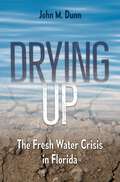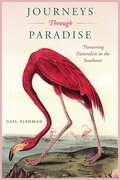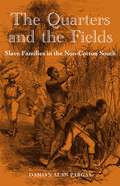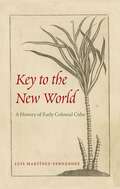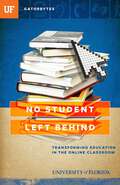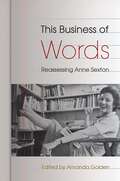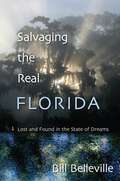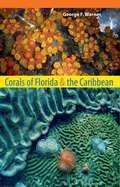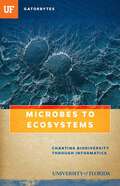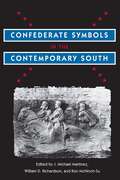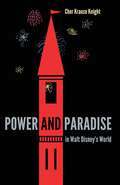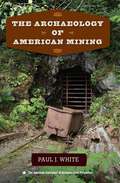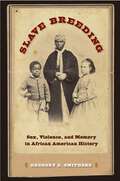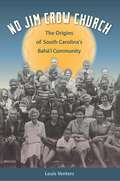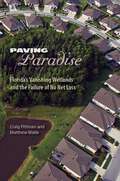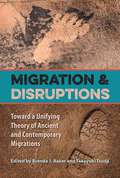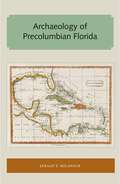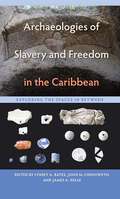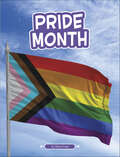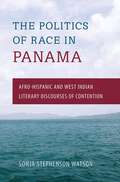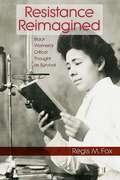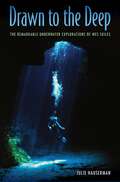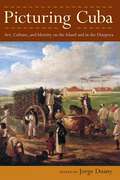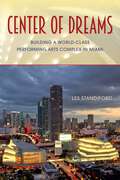- Table View
- List View
Drying Up: The Fresh Water Crisis in Florida
by John M. DunnAmerica’s wettest state is running out of water. Florida—with its swamps, lakes, extensive coastlines, and legions of life-giving springs—faces a drinking water crisis. Drying Up is a wake-up call and a hard look at what the future holds for those who call Florida home. Journalist and educator John Dunn untangles the many causes of the state’s freshwater problems. Drainage projects, construction, and urbanization, especially in the fragile wetlands of South Florida, have changed and shrunk natural water systems. Pollution, failing infrastructure, increasing outbreaks of toxic algae blooms, and pharmaceutical contamination are worsening water quality. Climate change, sea level rise, and groundwater pumping are spoiling freshwater resources with saltwater intrusion. Because of shortages, fights have broken out over rights to the Apalachicola River, Lake Okeechobee, the Everglades, and other important watersheds. Many scientists think Florida has already passed the tipping point, Dunn warns. Drawing on more than one hundred interviews and years of research, he affirms that soon there will not be enough water to meet demand if “business as usual” prevails. He investigates previous and current restoration efforts as well as proposed future solutions, including the “soft path for water” approach that uses green infrastructure to mimic natural hydrology. As millions of new residents are expected to arrive in Florida in the coming decades, this book is a timely introduction to a problem that will escalate dramatically—and not just in Florida. Dunn cautions that freshwater scarcity is a worldwide trend that can only be tackled effectively with cooperation and single-minded focus by all stakeholders involved—local and federal government, private enterprise, and citizens. He challenges readers to rethink their relationship with water and adopt a new philosophy that compels them to protect the planet’s most precious resource.
Journeys Through Paradise: Pioneering Naturalists in the Southeast
by Gail Fishman"This book is for those inhabited by the same desires that drove the early naturalists afield, who yearn to know wilder territory. We read it voraciously, as if in the understanding of how they loved we might also begin to do so, as if in the reliving of their lives we might recapture some vanishing part of the human psyche that must know wilderness."-- Janisse Ray, author of Ecology of a Cracker Childhood "Like the naturalists she profiles, Gail Fishman takes us on an odyssey through a time when the extraordinary diversity of the southeastern United States was first being explored and described. . . . Entertaining."-- Steve Gatewood, executive director, Society for Ecological Restoration, Tucson "Fishman modernizes the men and their explorations by retracing the terrain that they explored, wrote about, drew and painted. The result is an intriguing and appealing lesson in biographical and scientific history and a literary reading experience that will appeal to a wide audience."-- William W. Rogers, professor of history emeritus, Florida State University Following the original steps of pioneering naturalists, Gail Fishman profiles thirteen men who explored North America’s southeastern wilderness between 1715 and the 1940s, including John James Audubon, Mark Catesby, John and William Bartram, John Muir, and Alvan Wentworth Chapman. The book is also Fishman’s personal travelogue as she experiences the landscape through their eyes and describes the changes that have occurred along the region’s trails and streams. Traveling by horseback, boat, and foot, these naturalists--dedicated to their task and blessed with passion and insatiable curiosity--explored gentle mountains, regal forests, and shadowy swamps. Their interests ran deeper than merely cataloging plants and animals. They identified the continent’s foundations and the habits and histories of the flora and fauna of the landscape. Fishman tells us who they were and what compelled them to pursue their work. She evaluates what they accomplished and measures their importance, also pointing out their strengths and failings. And she paints an engaging picture of what America was like at the time. Fishman combines natural history and American history into a series of portraits that recapture the American Southeast as it was seen by those who first tramped through the wilderness and whose voices from the beginning urged the preservation of wild places. Gail Fishman, a freelance writer who lives in Tallahassee, has worked for the Florida Defenders of the Environment, The Nature Conservancy, and the National Audubon Society. She is a volunteer for the St. Marks National Wildlife Refuge and helped form the St. Marks Refuge Association.
The Quarters and the Fields: Slave Families in the Non-Cotton South (New Perspectives on the History of the South)
by Damian Alan PargasThe Quarters and the Fields offers a unique approach to the examination of slavery. Rather than focusing on slave work and family life on cotton plantations, Damian Pargas compares the practice of slavery among the other major agricultural cultures in the nineteenth-century South: tobacco, mixed grain, rice, and sugar cane. He reveals how the demands of different types of masters and crops influenced work patterns and habits, which in turn shaped slaves' family life.By presenting a broader view of the complex forces that shaped enslaved people's family lives, not only from outside but also from within, this book takes an inclusive approach to the slave agency debate. A comparative study that examines the importance of time and place for slave families, The Quarters and the Fields provides a means for understanding them as they truly were: dynamic social units that were formed and existed under different circumstances across time and space.
Key to the New World: A History of Early Colonial Cuba
by Luis Martínez-FernándezFlorida Book Awards, Bronze Medal for General Nonfiction Scholarly and popular attention tends to focus heavily on Cuba’s recent history. Key to the New World is the first comprehensive history of early colonial Cuba written in English, and fills the gap in our knowledge of the island before 1700.
No Student Left Behind: Transforming Education in the Online Classroom
by University of Florida Jon SilmanThe University of Florida has an ambitious goal: to harness the power of its faculty, staff, students, and alumni to solve some of society's most pressing problems and to become a resource for the state of Florida, the nation, and the world. For many years, higher education was mostly limited to affluent white males, but distance-learning helped open the door to students from all walks of life. Today, the Internet is picking up where distance-learning left off, transforming not only where and how we learn but also who can be a student. At the center of this quest to break down barriers to learning and move closer to the ideal of learning for all is Carole Beal, head of the University of Florida's new Online Learning Institute. Along with Beal, collaborators from UF's colleges of Education, Engineering, Journalism and Communications, and the Arts team up to combine technology and pedagogy with the aim of helping students who might otherwise be left behind, including students with disabilities. The interdisciplinary efforts of the institute also feature the work of UF's Digital Worlds Institute and UF Online, one of the nation's first totally online undergraduate programs. No Student Left Behind traces the earliest correspondence programs to the most cutting-edge practices of online learning at UF, looking at some of the first implementations of an online class and exploring how the brain works in front of a computer screen. The stories chronicled in GATORBYTES span all colleges and units across the UF campus. They detail the far-reaching impact of UF's research, technologies, and innovations--and the UF faculty members dedicated to them. Gatorbytes describe how UF is continuing to build on its strengths and extend the reach of its efforts so that it can help even more people in even more places.
This Business of Words: Reassessing Anne Sexton
by Amanda GoldenOne of America's most influential women writers, Anne Sexton has long been overshadowed by fellow confessional poets Sylvia Plath and Robert Lowell and is seldom featured in literary criticism. This volume reassesses Sexton and her poetry for the first time in two decades and offers directions for future Sexton scholarship. Mapping Sexton’s influence on twenty-first-century cultural contexts, these essays emphasize her continuing vitality. Contributors: Jeanne Marie Beaumont | Jeffery Conway | Jo Gill | Amanda Golden | Christopher Grobe | Anita Helle | Kamran Javadizadeh | Dorothea Lasky | Kathleen Ossip | David Trinidad | Victoria Van Hyning
Salvaging the Real Florida: Lost and Found in the State of Dreams
by Bill BellevilleModern life has a tendency to trap people in cubicles, cars, and cookie-cutter suburbs. Thankfully, someone comes along now and then to remind us of the beauty that presents itself when we turn off the information feeds and turn away from the daily grind. Bill Belleville’s enchanting Salvaging the Real Florida invites readers to rediscover treasures hidden in plain sight. Join Belleville as he paddles a glowing lagoon, slogs through a swamp, explores a spring cave, dives a "literary" shipwreck, and pays a visit to the colorful historic district of an old riverboat town. Journey with him in search of the apple snail, the black bear, a rare cave-dwelling shrimp, and more. Everywhere he goes, Belleville finds beauty, intrigue, and, more often than not, a legacy in peril. Following in the tradition of John Muir, William Bartram, and Henry David Thoreau, Belleville forges intimate connections with his surroundings. Like the works of Marjory Stoneman Douglas and Archie Carr, his evocative stories carry an urgent and important call to preserve what is left of the natural world.
Corals of Florida and the Caribbean
by George F. WarnerPresenting a stunning array of beauty and biodiversity, the coral reefs of Florida and the Caribbean are part playground, part research lab for the thousands of tourists, divers, and marine scientists who visit them every year. Documenting the wide array of corals at home in the warm waters of the Caribbean, George Warner's Corals of Florida and the Caribbean provides an easy-to-use (and carry) guidebook that is both scientifically accurate and reader friendly.Warner provides an exhaustive identification guide that will enrich any novice's vacation dive or an expert's return to the reefs. Written for the amateur naturalist, this handbook will travel well throughout the Caribbean, from Florida south to Belize, east to Tobago, and all points in between.Beyond documenting the wide variety of corals found in the Caribbean, Warner also outlines their biology, from the way they grow to their reproductive habits, while examining major threats to the reefs including hurricanes, pollution, and global warming. With over 150 color photos, most taken by the author himself, as well as detailed descriptions, Corals of Florida and the Caribbean makes identifying and learning about corals hassle free--on the boat, at home, or in the classroom.
Microbes to Ecosystems: Charting Biodiversity through Informatics
by University of Florida Blake D. EdgarThe University of Florida has an ambitious goal: to harness the power of its faculty, staff, students, and alumni to solve some of society’s most pressing problems and to become a resource for the state of Florida, the nation, and the world. In Microbes to Ecosystems, follow the scientists, researchers, and staff of the University of Florida’s Biodiversity Institute as they marshal unprecedented amounts of biological data to help us conserve species, adapt to climate change, and solve pressing environmental problems. With a twenty-first-century, interdisciplinary approach, the Biodiversity Institute unites some of the most prominent researchers and state-of-the-art resources in the biological sciences, genomics, and informatics. Together they innovate new methods and technologies to accelerate discovery, communicate data and understanding, and determine potential solutions for maintaining sustainable environments. Connections are critical to both ecological and computational systems, and the institute aims to build connections that can help us more effectively study and save biological diversity, including connecting perspectives between the natural sciences and social sciences and connecting scientific research to regulatory policy. Central to the institute’s efforts is the Florida Museum of Natural History—the second largest university-based natural history museum in the country and home to more than 40 million specimens and artifacts—and iDigBio, the national center for creating a digital catalog of the earth’s flora and fauna. The stories chronicled in Gatorbytes span all colleges and units across the UF campus. They detail the far-reaching impact of UF’s research, technologies, and innovations—and the UF faculty members dedicated to them. Gatorbytes describe how UF is continuing to build on its strengths and extend the reach of its efforts so that it can help even more people in even more places.
Confederate Symbols in the Contemporary South
by J. Michael Martinez, William D. Richardson, and Ron McNinch-SuA timely collection of essays examining the controversy surrounding the use & display of Confederate symbols in the modern South.
Power and Paradise in Walt Disney's World
by Cher Krause KnightIn this fascinating analysis, Cher Krause Knight peels back the actual and contextual layers of Walt Disney's inspiration and vision for Disney World in central Florida, exploring the reasons why the resort has emerged as such a prominent sociocultural force. Knight investigates every detail, from the scale and design of the buildings to the sidewalk infrastructure to which items could and could not be sold in the shops, discussing how each was carefully configured to shape the experience of every visitor. Expertly weaving themes of pilgrimage, paradise, fantasy, and urbanism, she delves into the unexpected nuances and contradictions of this elaborately conceived playland of the imagination.
The Archaeology of American Mining (The American Experience in Archaeological Perspective)
by Paul J. WhiteMining History Association Clark C. Spence Award The mining industry in North America has a rich and conflicted history. It is associated with the opening of the frontier and the rise of the United States as an industrial power but also with social upheaval, the dispossession of indigenous lands, and extensive environmental impacts. Synthesizing fifty years of research on American mining sites that date from colonial times to the present, Paul White provides an ideal overview of the field for both students and professionals. The Archaeology of American Mining offers a multifaceted look at mining, incorporating findings from an array of subfields, including historical archaeology, industrial archaeology, and maritime archaeology. Case studies are taken from a wide range of contexts, from eastern coal mines to Alaskan gold fields, with special attention paid to the domestic and working lives of miners. Exploring what material artifacts can tell us about the lives of people who left few records, White demonstrates how archaeologists contribute to our understanding of the legacies left by miners and the mining industry. A volume in the series the American Experience in Archaeological Perspective, edited by Michael S. Nassaney
Slave Breeding: Sex, Violence, and Memory in African American History
by Gregory D. SmithersFor over two centuries, the topic of slave breeding has occupied a controversial place in the master narrative of American history. From nineteenth-century abolitionists to twentieth-century filmmakers and artists, Americans have debated whether slave owners deliberately and coercively manipulated the sexual practices and marital status of enslaved African Americans to reproduce new generations of slaves for profit.In this bold and provocative book, historian Gregory Smithers investigates how African Americans have narrated, remembered, and represented slave-breeding practices. He argues that while social and economic historians have downplayed the significance of slave breeding, African Americans have refused to forget the violence and sexual coercion associated with the plantation South. By placing African American histories and memories of slave breeding within the larger context of America’s history of racial and gender discrimination, Smithers sheds much-needed light on African American collective memory, racialized perceptions of fragile black families, and the long history of racially motivated violence against men, women, and children of color.
No Jim Crow Church: The Origins of South Carolina's Bahá'í Community
by Louis Venters"A richly detailed study of the rise of the Bahá’í Faith in South Carolina. There isn’t another study out there even remotely like this one."--Paul Harvey, coauthor of The Color of Christ: The Son of God and the Saga of Race in America "A pioneering study of how and why the Bahá’í Faith became the second largest religious community in South Carolina. Carefully researched, the story told here fills a significant gap in our knowledge of South Carolina's rich and diverse religious history."--Charles H. Lippy, coauthor of Religion in Contemporary America The emergence of a cohesive interracial fellowship in Jim Crow-era South Carolina was unlikely and dangerous. However, members of the Bahá’í Faith in the Palmetto State rejected segregation, broke away from religious orthodoxy, and defied the odds, eventually becoming the state’s largest religious minority. The religion, which emphasizes the spiritual unity of all humankind, arrived in the United States from the Middle East at the end of the nineteenth century via urban areas in the Northeast and Midwest. Expatriate South Carolinians converted and when they returned home, they brought their newfound religion with them. Despite frequently being the targets of intimidation, and even violence, by neighbors, the Ku Klux Klan, law enforcement agencies, government officials, and conservative clergymen, the Bahá’ís remained resolute in their faith and their commitment to an interracial spiritual democracy. In the latter half of the twentieth century, their numbers continued to grow, from several hundred to over twenty thousand. In No Jim Crow Church, Louis Venters traces the history of South Carolina’s Bahá’í community from its early origins through the civil rights era and presents an organizational, social, and intellectual history of the movement. He relates developments within the community to changes in society at large, with particular attention to race relations and the civil rights struggle. Venters argues that the Bahá’ís in South Carolina represented a significant, sustained, spiritually-based challenge to the ideology and structures of white male Protestant supremacy, while exploring how the emergence of the Bahá’í Faith in the Deep South played a role in the cultural and structural evolution of the religion.
Paving Paradise: Florida's Vanishing Wetlands and the Failure of No Net Loss (Florida History and Culture)
by Craig Pittman Matthew WaiteFlorida possesses more wetlands than any other state except Alaska, yet since 1990 more than 84,000 acres have been lost to development despite presidential pledges to protect them.How and why the state's wetlands are continuing to disappear is the subject of Paving Paradise. Journalists Craig Pittman and Matthew Waite spent nearly four years investigating the political expedience, corruption, and negligence on the part of federal and state agencies that led to a failure to enforce regulations on developers. They traveled throughout the state, interviewed hundreds of people, dug through thousands of documents, and analyzed satellite imagery to identify former wetlands that were now houses, stores, and parking lots.Exposing the unseen environmental consequences of rampant sprawl, Pittman and Waite explain how wetland protection creates the illusion of environmental protection while doing little to stem the tide of destruction.
Migration and Disruptions: Toward a Unifying Theory of Ancient and Contemporary Migrations
by Brenda J. Baker and Takeyuki Tsuda“Artfully integrates scholarship on both past and present migration. With its thematic focus on disruption, this volume develops unprecedented nuance in the treatment of migration.”—Graciela S. Cabana, coeditor of Rethinking Anthropological Perspectives on Migration “A significant contribution to the social sciences in general and a future staple for archaeologists and anthropologists. Migration and Disruptions demonstrates the importance of collaboration and constructive dialogues between the traditional subfields composing the umbrella title of anthropology.”—Stephen A. Brighton, author of Historical Archaeology of the Irish Diaspora: A Transnational Approach Migration has always been a fundamental human activity, yet little collaboration exists between scientists and social scientists examining how it has shaped past and contemporary societies. This innovative volume brings together sociocultural anthropologists, archaeologists, bioarchaeologists, ethnographers, paleopathologists, and others to develop a unifying theory of migration. The contributors relate past movements, including the Anglo-Saxon settlement of Britain and the Islamic conquest of Andalucía, to present-day events, such as those in northern Ethiopia or at the U.S.-Mexico border. They examine the extent to which environmental and social disruptions have been a cause of migration over time and how these migratory flows have in turn led to disruptive consequences for the receiving societies. The observed cycles of social disruption, resettlement, and its consequences offer a new perspective on how human migration has shaped the social, economic, political, and environmental landscapes of societies from prehistory to today. Contributors:Brenda J. Baker | Christopher S. Beekman | George L. Cowgill | Jason De Leon | James F. Eder | Anna Forringer-Beal | Cameron Gokee | Catherine Hills | Kelly J. Knudson | Patrick Manning | Jonathan Maupin | Lisa Meierotto | James Morrissey | Rachel E. Scott | Christina Torres-Rouff | Takeyuki (Gaku) Tsuda | Sonia Zakrzewski
Fort St. Joseph Revealed: The Historical Archaeology of a Fur Trading Post
by Michael S. NassaneyFort St. Joseph Revealed is the first synthesis of archaeological and documentary data on one of the most important French colonial outposts in the western Great Lakes region. Located in what is now Michigan, Fort St. Joseph was home to a flourishing fur trade society from the 1680s to 1781. Material evidence of the site—lost for centuries—was discovered in 1998 by volume editor Michael Nassaney and his colleagues, who summarize their extensive excavations at the fort and surrounding areas in these essays. Contributors analyze material remains including animal bones, lead seals, smudge pits, and various other detritus from daily life to reconstruct the foodways, architectural traditions, crafts, trade, and hide-processing methods of the fur trade. They discuss the complex relationship between the French traders and local Native populations, who relied on each other for survival and forged links across their communities through intermarriage and exchange, even as they maintained their own cultural identities. Faunal remains excavated at the site indicate the French quickly adopted Native cuisine, as they were unable to transport perishable goods across long distances. Copper kettles and other imported objects from Europe were transformed by Native Americans into decorative ornaments such as tinkling cones, and French textiles served as a medium of stylistic expression in the multi-ethnic community that developed at Fort St. Joseph. Featuring a thought-provoking look at the award-winning public archaeology program at the site, this volume will inspire researchers with the potential of community-based service-learning initiatives to tap into the analytical power at the interface of history and archaeology. Contributors: Rory J. Becker | Kelley M. Berliner | José António Brandão | Cathrine Davis | Erica A. D’Elia | Brock Giordano, RPA | Joseph Hearns | Allison Hoock | Mark W. Hoock | Erika Hartley | Terrance J. Martin | Eric Teixeira Mendes | Michael S. Nassaney | Susan K. Reichert
Archaeology of Precolumbian Florida (Florida and the Caribbean Open Books Series)
by Jerald T. MilanichThe books in the Florida and the Caribbean Open Books Series demonstrate the University Press of Florida’s long history of publishing Latin American and Caribbean studies titles that connect in and through Florida, highlighting the connections between the Sunshine State and its neighboring islands. Books in this series show how early explorers found and settled Florida and the Caribbean. They tell the tales of early pioneers, both foreign and domestic. They examine topics critical to the area such as travel, migration, economic opportunity, and tourism. They look at the growth of Florida and the Caribbean and the attendant pressures on the environment, culture, urban development, and the movement of peoples, both forced and voluntary. The Florida and the Caribbean Open Books Series gathers the rich data available in these architectural, archaeological, cultural, and historical works, as well as the travelogues and naturalists’ sketches of the area in prior to the twentieth century, making it accessible for scholars and the general public alike. The Florida and the Caribbean Open Books Series is made possible through a grant from the National Endowment for the Humanities and the Andrew W. Mellon Foundation, under the Humanities Open Books program.
Archaeologies of Slavery and Freedom in the Caribbean: Exploring the Spaces in Between ( Florida Museum of Natural History: Ripley P. Bullen Series)
by Lynsey A. Bates, John M. Chenoweth and James A. DelleCaribbean plantations and the forces that shaped them--slavery, sugar, capitalism, and the tropical, sometimes deadly environment--have been studied extensively. This volume brings together alternate stories of sites that fall outside the large cash-crop estates. Employing innovative research tools and integrating data from Dominica, St. Lucia, the Dominican Republic, Jamaica, Barbados, Nevis, Montserrat, and the British Virgin Islands, the contributors investigate the oft-overlooked interstitial spaces where enslaved Africans sought to maintain their own identities inside and outside the fixed borders of colonialism. Despite grueling work regimes and social and economic restrictions, people held in bondage carved out places of their own at the margins of slavery's reach. These essays reveal a complex world within and between sprawling plantations--a world of caves, gullies, provision grounds, field houses, fields, and the areas beyond them, where the enslaved networked, interacted, and exchanged goods and information. The volume also explores the lives of poor whites, Afro-descendant members of military garrisons, and free people of color, demonstrating that binary models of black slaves and white planters do not fully encompass the diversity of Caribbean identities before and after emancipation. Together, the analyses of marginal spaces and postemancipation communities provide a more nuanced understanding of the experiences of those who lived in the historic Caribbean, and who created, nurtured, and ultimately cut the roots of empire. A volume in the Florida Museum of Natural History: Ripley P. Bullen Series
Pride Month
by Steve FoxePride Month is about celebrating the lives and activism of LGBTQ+ people around the world. It started as a way of remembering the 1969 Stonewall Uprising in New York City. During Pride Month, communities have festivals, parades, and marches. Some organize events in places where LGBTQ+ people face discrimination to help fight for equal rights. Readers will discover how a shared holiday can have multiple traditions and be celebrated in all sorts of ways.
The Politics of Race in Panama: Afro-Hispanic and West Indian Literary Discourses of Contention
by Sonja S. Watson"Delves into the historical convergence of peoples and cultural traditions that both enrich and problematize notions of national belonging, identity, culture, and citizenship."--Antonio D. Tillis, editor of Critical Perspectives on Afro-Latin American Literature "With rich detail and theoretical complexity, Watson reinterprets Panamanian literature, dismantling longstanding nationalist interpretations and linking the country to the Black Atlantic and beyond. An engaging and important contribution to our understanding of Afro-Latin America."--Peter Szok, author of Wolf Tracks: Popular Art and Re-Africanization in Twentieth-Century Panama "Illuminates the deeper discourse of African-descendant identities that runs through Panama and other Central American countries."--Dawn Duke, author of Literary Passion, Ideological Commitment: Toward a Legacy of Afro-Cuban and Afro-Brazilian Women Writers This volume tells the story of two cultural groups: Afro-Hispanics, whose ancestors came to Panama as African slaves, and West Indians from the English-speaking countries of Jamaica and Barbados who arrived during the mid-nineteenth and early-twentieth centuries to build the railroad and the Panama Canal. While Afro-Hispanics assimilated after centuries of mestizaje (race mixing) and now identify with their Spanish heritage, West Indians hold to their British Caribbean roots and identify more closely with Africa and the Caribbean. By examining the writing of black Panamanian authors, Sonja Watson highlights how race is defined, contested, and inscribed in Panama. She discusses the cultural, racial, and national tensions that prevent these two groups from forging a shared Afro-Panamanian identity, ultimately revealing why ethnically diverse Afro-descendant populations continue to struggle to create racial unity in nations across Latin America and the Caribbean. Sonja Stephenson Watson is director of the Women’s and Gender Studies Program and associate professor of Spanish at the University of Texas at Arlington. A volume in the series Latin American and Caribbean Arts and Culture, funded by the Andrew W. Mellon Foundation.
Resistance Reimagined: Black Women's Critical Thought as Survival
by Regis M. FoxResistance Reimagined highlights unconventional modes of black women's activism within a society that has spoken so much of freedom but has granted it so selectively. Looking closely at nineteenth- and twentieth-century writings by African American women that reimagine antebellum America, Regis Fox introduces types of black activism that differ from common associations with militancy and maleness. In doing so, she confronts expectations about what African American literature can and should be. Fox analyzes Harriet Wilson's Our Nig, Elizabeth Keckly's Behind the Scenes, Anna Julia Cooper's A Voice From the South, and Sherley Anne Williams's Dessa Rose. The thinkers highlighted by Fox have been dismissed as elitist, accommodationist, or complicit—yet Fox reveals that in reality, these women use their writing to protest antiblack violence, reject superficial reform, call for major sociopolitical change, and challenge the false promises of American democracy.
Drawn to the Deep: The Remarkable Underwater Explorations of Wes Skiles
by Julie HausermanDan's Cave looks like the entrance to the underworld. Two divers swim along a luminous blue-green passage, flashlights cutting through the water, a dark mass of stalactites suspended overhead. This is the breathtaking National Geographic cover photo taken by Wes Skiles (1958–2010), a top nature photographer who died in a diving accident before the issue was published. Drawn to the Deep celebrates the life of an extraordinary adventurer who braved extreme danger to share the hidden beauty and environmental truths of the planet with others. Skiles felt a pull to the water as a child, captivated by the cobalt springs of Florida. His passion for diving and his innovative camera techniques earned him assignments with National Geographic and Outside. He also took part in creating over a hundred films, many of which won international awards and acclaim. Skiles was a self-taught expert on Florida's freshwater springs and an outspoken advocate for their conservation. He went head to head with scientists and government officials who dismissed his firsthand observations of water movement through the "Swiss-cheese" karst rock of the underground aquifer. But he never gave up on his quest to disprove the prevailing scientific models or to protest what they allowed—the unchecked pumping and depletion of Florida's groundwater. Through interviews with Skiles's friends and family, along with insights from his own journals, Julie Hauserman describes the escapades and achievements that characterized his life's work. This book is the inspiring story of an explorer and activist who uncovered environmental abuses, advanced the field of underwater photography, and astonished the world with unprecedented views of the secret depths of the planet.
Picturing Cuba: Art, Culture, and Identity on the Island and in the Diaspora
by Jorge DuanyPicturing Cuba explores the evolution of Cuban visual art and its links to cubanía, or Cuban cultural identity. Featuring artwork from the Spanish colonial, republican, and postrevolutionary periods of Cuban history, as well as the contemporary diaspora, these richly illustrated essays trace the creation of Cuban art through shifting political, social, and cultural circumstances. Contributors examine colonial-era lithographs of Cuba’s landscape, architecture, people, and customs that portrayed the island as an exotic, tropical location. They show how the avant-garde painters of the vanguardia, or Havana School, wrestled with the significance of the island’s African and indigenous roots, and they also highlight subversive photography that depicts the harsh realities of life after the Cuban Revolution. They explore art created by the first generation of postrevolutionary exiles, which reflects a new identity—lo cubanoamericano, Cuban-Americanness—and expresses the sense of displacement experienced by Cubans who resettled in another country. A concluding chapter evaluates contemporary attitudes toward collecting and exhibiting post-revolutionary Cuban art in the United States. Encompassing works by Cubans on the island, in exile, and born in America, this volume delves into defining moments in Cuban art across three centuries, offering a kaleidoscopic view of the island’s people, culture, and history. Contributors: Anelys Alvarez | Lynnette M. F. Bosch | María A. Cabrera Arús | Iliana Cepero | Ramón Cernuda | Emilio Cueto | Carol Damian | Victor Deupi | Jorge Duany | Alison Fraunhar | Andrea O’Reilly Herrera | Jean-François Lejeune | Abigail McEwen | Ricardo Pau-Llosa | E. Carmen Ramos
Center of Dreams: Building a World-Class Performing Arts Complex in Miami
by Les StandifordDiscover how one spectacular building project revolutionized Miami, how one man's moxie helped turn a fractious tropical city into a cultural capital of the Americas. In Center of Dreams, New York Times bestselling author Les Standiford tells the inspiring story of the Adrienne Arsht Center for the Performing Arts. The vision for this building, which would become the most ambitious cultural arts complex since the Kennedy Center, began in an unlikely place and time. Miami in the 1970s was divided by social and ethnic tensions. The city comprised a growing population of immigrants from the Cuban revolution, a well-established African American community, Florida "crackers," and a continual influx of tourists and retirees. Critics said a cultural center would never be possible in a place of such extreme diversity. But Parker Thomson, a lawyer and Boston transplant, knew his adopted city could become a world-leading community in the twenty-first century. He believed a performing arts center was critical to this vision. Everyone said his dream was impossible, he would never succeed, it couldn't be done. Not in Miami. But Thomson persevered against political opposition, economic roadblocks, and engineering problems. It took thirty years to overcome the odds and the obstacles, but he finally made the dream a reality. With Thomson's efforts, along with help from cultural leaders, iconic design work by architect Cesar Pelli, and support from philanthropist Adrienne Arsht, the center opened its doors in 2006 with a star-studded gala. Today the Arsht Center is a cutting-edge venue of style and art, a landmark beloved by the city's residents, and a magnet for tourists from all over the world. Presenting performances that celebrate the richness of Miami's diverse population, it showcases emerging local artists and attracts international stars. Resident companies include the New World Symphony, the Florida Grand Opera, and the Miami City Ballet. Its improbable story is a testament to the influence of cultural advocacy, the importance of government support for the arts, and the power of the arts to repair and sustain communities.
